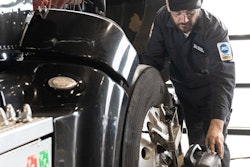
Beginning last Monday, CCJ published a six-part series on Commercial Vehicle Safety Alliance’s Roadcheck blitz, which kicked off Tuesday.
I hope the nearly bumper-to-bumper series was a simple, high-level reminder of basic maintenance best practices. Maybe it served as the impetus for a thorough system check just in case.
Safety and solid maintenance fundamentals are always important, and they are no more important today through Thursday than they were all of last month, or from this coming Friday and beyond. Safety is an everyday thing and there's really nothing special about CVSA's Roadcheck.
During International Roadcheck, CVSA-certified inspectors primarily conduct the North American Standard Level I Inspection – a 37-step process to confirm compliance with driver operating requirements and vehicle mechanical fitness. However, inspectors may instead opt to conduct the Level II Walk-Around Driver/Vehicle Inspection, Level III Driver/Credential/Administrative Inspection or Level V Vehicle-Only Inspection.
Delaware State Police Sergeant and CVSA President John Samis noted that "inspections conducted [during] Roadcheck are no different from inspections conducted any other day of the year. Other than data collection, the inspection process is the same."
You are no more or less likely to get dinged for a violation this week than you were last week if you're skirting the rules.
The focus of this week's "revenue roundup" (yes, I read some of the comments posted on CCJ's articles) is hours of service violations and lights – the top driver and truck out of service violations. According to the Federal Motor Carrier Safety Administration, the lighting violation “lamps inoperable” (Title 49 Code of Federal Regulations 393.9) was the number one vehicle violation in 2020, accounting for approximately 12.24% of all vehicle violations discovered that year. And during last year’s International Roadcheck, the top driver out of service violation category in North America was hours of service, accounting for 34.7% of all driver out of service conditions.
While special emphasis will be placed on driver logs and lights, it's still open season on the rest of the vehicle and the person in the driver's seat.
Inspectors will ensure the vehicle’s brake systems, cargo securement, coupling devices, driveline/driveshaft components, driver’s seat, exhaust systems, frames, fuel systems, lighting devices, steering mechanisms, suspensions, tires, van and open-top trailer bodies, wheels, rims, hubs and windshield wipers are all compliant with regulations. Drivers should also expect a review of their operating credentials (license and class), hours of service documentation, seat belt usage, and a check for alcohol and/or drug impairment.
Data suggests most carriers' maintenance and inspection programs are up to par. For example, last year more than 50,100 inspections were conducted through Canada, Mexico and the U.S., and the overall vehicle out of service rate in North America for Level I, II and V Inspections combined was 20.9%. Last year's truck out of service rate was about 3% higher than the year before, but considering we were still knee-deep into a pandemic during last September's campaign, I think it could have been a lot worse.
Recent results show that 80% (+/-) of fleets are doing their part to change the narrative that truck drivers are dangerous. I've seen studies that suggest upwards of 75% of passenger car drivers are fearful of sharing the road with semis – a stat that doesn't wash with the reality that the vast majority of accidents involving big rigs are the fault of the four-wheeler.
Enforcement checkups like Roadcheck, Brake Safety Week and Safe Driver Week can be cumbersome and frustrating, but are a necessary evil to identify the bad actors that make doing business so difficult (and expensive) for the rest.










